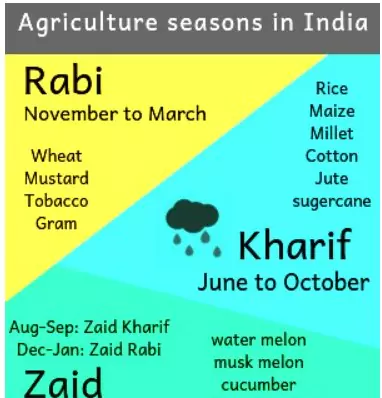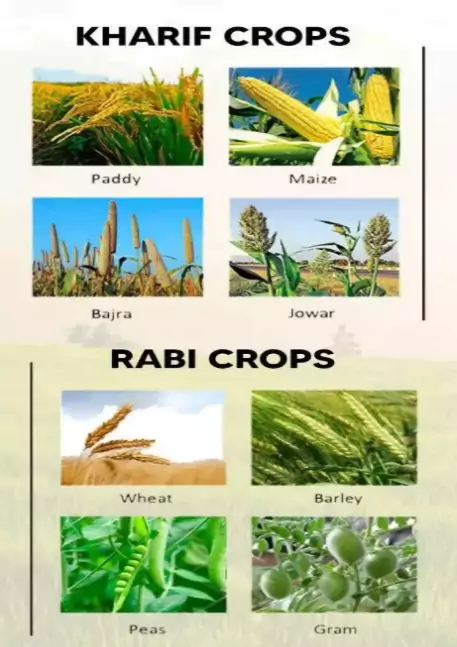Kharif and Rabi Crops are India’s two main agricultural seasons. Kharif crops (like rice and maize) are sown with the monsoon in June–July, while Rabi crops (like wheat and mustard) are sown post-monsoon in October–November. A third, shorter season, Zaid crops include summer-grown crops like watermelon and cucumber.

Kharif and Rabi Crops: Agriculture in India works in cycles that follow the pattern of climate and rainfall. The country depends on two major crop seasons called Kharif and Rabi Crops. These crops grow at different times of the year depending on temperature, soil conditions, and the amount of water available.
Farmers rely on these crop cycles to produce food for the population and raw materials for industries. Apart from these two main crop seasons, there is also a short season called the Zaid season, which helps in additional food supply. Here we dive deep into these crop types and cover all the important details.

The farming system in India is classified into three main crop categories: Kharif, Rabi, and Zaid. Kharif and Rabi Crops are the primary crop cycles, while Zaid crops are grown for a shorter duration.

Kharif crops are cultivated during the rainy season, and Rabi crops are cultivated during winter. Zaid’s crops are grown in the summer months between these two seasons. Provided here is the gist of these:
| Category | Kharif Crops | Rabi Crops | Zaid Crops |
| Season of Sowing | June–July (monsoon begins) | October–November (after monsoon) | March–June (summer months) |
| Season of Harvesting | September–October | March–April | May–July |
| Climate Requirement | Hot and humid with heavy rains | Cool and dry with little rainfall | Hot summer with irrigation |
| Water Source | Monsoon rainfall | Irrigation sources | Irrigation sources |
| Examples | Rice, maize, cotton, groundnut | Wheat, barley, mustard, gram | Watermelon, cucumber, muskmelon |
Kharif crops are grown during the rainy season in India. They are sown in June and July, at the beginning of the monsoon, and harvested in September and October. These crops need hot and humid weather to grow. They depend heavily on monsoon rains for water.
Rice is the most important Kharif crop in India because it requires standing water in fields. Other crops include maize, cotton, sugarcane, and groundnut. These crops not only provide food but also raw materials for industries.
The characteristics of Kharif crops help us understand why they are suitable for the rainy season. Covered here is the important characteristics of Kharif crops which makes them different from others:
The following Kharif crop examples show the diversity of crops grown in the rainy season. Rice and maize are the main food grains grown. Mentioned below is the table that covers more such Kharif crop examples:
| Crop Type | Examples |
| Food grains | Rice, maize, jowar, bajra |
| Cash crops | Cotton, sugarcane, jute |
| Oilseeds | Groundnut, soybean, sesame |
| Others | Turmeric, pulses, chillies |
Rabi crops are those that are cultivated during the winter season in India. Farmers sow them in October and November, after the monsoon rains have ended. They are harvested in March and April, just before the summer season begins.
These crops need a cooler climate for growth and depend less on rainfall compared to Kharif crops. Irrigation systems, like canals and wells, support their growth. Wheat is the most widely grown Rabi crop, along with barley, mustard, and pulses.
The characteristics of Rabi crops make them unique and different from Kharif crops. Mentioned here are key characteristics of Rabi crops refer to the points mentioned below:
Cool weather requirement: Rabi crops grow best in low temperatures. The winter season provides the right conditions for their growth.
There are several important Rabi crops examples in India. These include food grains, pulses, and oilseeds. Check the table below for such Rabi crop examples:
| Crop Type | Examples |
| Food grains | Wheat, barley, oats |
| Pulses | Gram (chickpeas), peas, lentils |
| Oilseeds | Mustard, linseed, sunflower |
| Others | Carrot, onion, garlic |
The difference between Kharif and Rabi crops is clear when we compare them. Kharif crops depend on monsoon rains, while Rabi crops depend on irrigation. The difference between Kharif and Rabi Crops is highlighted well in table below:
| Feature | Kharif Crops | Rabi Crops |
| Season of Sowing | June–July | October–November |
| Season of Harvesting | September–October | March–April |
| Climate Requirement | Hot and humid | Cool and dry |
| Water Need | Heavy rainfall | Less rainfall, more irrigation |
| Main Crops | Rice, maize, cotton, groundnut | Wheat, barley, mustard, gram |
Zaid Crops are short-duration crops that grow between March and June. They fill the gap between Rabi and Kharif seasons. Zaid crops are fast-growing and provide farmers with additional income. They need hot weather and plenty of irrigation.
Unlike Kharif crops, they are not dependent on rain. Farmers often grow fruits and vegetables during this season, such as melons and cucumbers, which are in demand during summer.
Mentioned here are some of the salient features of Zaid crops. Knowing these features will help one understand the difference between the various crop types:
Here are some common examples of Zaid crops. These crops are usually fruits and vegetables that people consume during the summer. Refer to the table below to know more Zaid crop examples:
| Crop Type | Examples |
| Fruits | Watermelon, muskmelon |
| Vegetables | Cucumber, bitter gourd, pumpkin |
| Others | Fodder crops, seasonal pulses |
Ready to boost your UPSC 2026 preparation? Join PW’s UPSC online courses today!
Kharif and Rabi Crops are two types of crops in India based on the season. Kharif crops grow in the rainy season, while Rabi crops grow in the winter season.
Rabi crops are grown in winter. They are sown in October–November and harvested in March–April.
Kharif crops are grown in the rainy season. They are sown in June–July and harvested in September–October.
Examples of Rabi crops include wheat, barley, mustard, and peas.
Examples of Kharif crops include rice, maize, cotton, and groundnut.

<div class="new-fform">
</div>